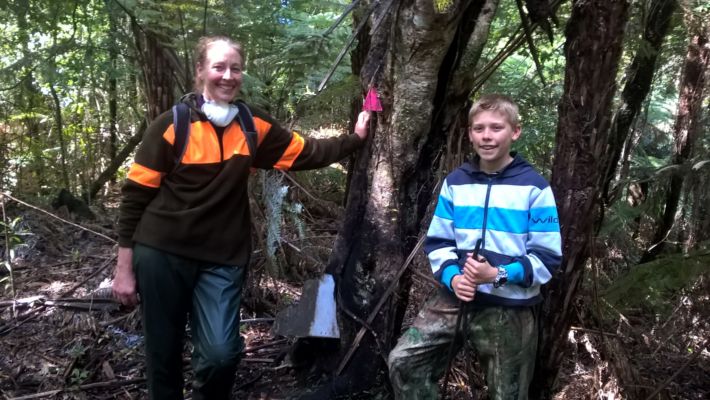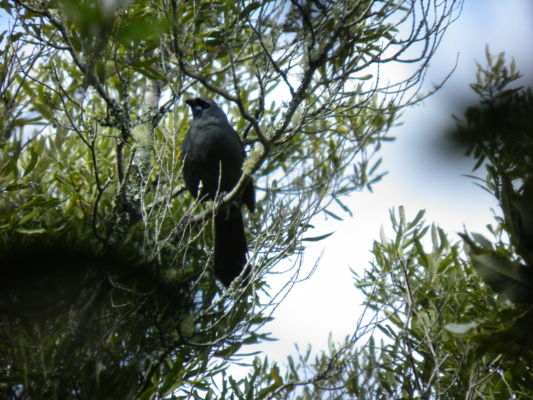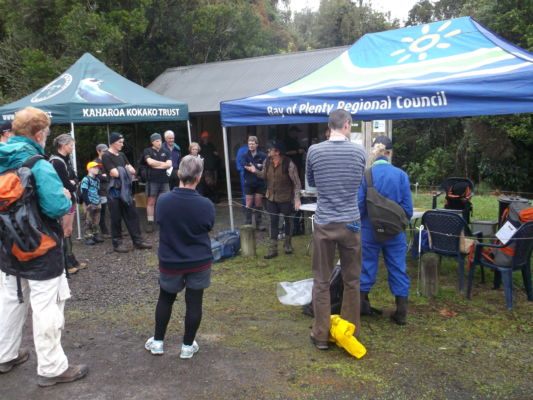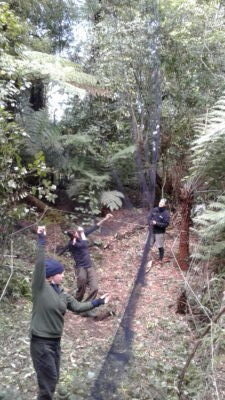Back in the 1990s, Kaharoa Forest near Rotorua was one of three forests involved in an 8-year ‘Research by Management’ project to discover why kokako populations were still declining even though large-scale forest clearance had stopped. Competition for food by possums and introduced predators like ship rats were suspected as the cause.

Carmel Richardson had young children and lived near the forest – volunteering to help her friend Hazel Speed with surveys was a way to get out of the house and into the forest some weekends to help in conservation. In Kaharoa Forest, pest control was carried out targeting possums and ship rats during the first three years of the project. Although kokako numbers were low (22 birds in total, comprising 7 pairs and 8 singles), once pest control got going the bird numbers took off.
“We had 85% of kokako pairs successfully fledge their chicks in the 3rd year of pest control,” Carmel says.
The second part of the project involved four years without pest control in Kaharoa, but with continued monitoring of kokako (both their numbers and their breeding success) as well as monitoring pest numbers.
“It was heartbreaking,” says Carmel. “Fledging success went down to 27% in the 1st year without pest control, then 13% the 2nd year and in the last two years of the research work no kokako successfully fledged any chicks. Basically, the forest was crawling with pests again, the chicks were all being eaten by predators, and adult kokako, particularly females on nests, were also being preyed on. During the research work we found that possums were not just herbivores munching up our forests but were also actively preying on our wildlife”.
At the end of the Research by Management project in 1997 and with the benefits of pest control scientifically demonstrated, the Department of Conservation (DOC) were planning to resume pest control in Kaharoa Forest – but missed out on funding for it that year – a huge disappointment for Hazel and Carmel. Soon after learning there would be no pest control in Kaharoa that year however, Carmel was asked by DOC to visit a local farmer who thought he might have kokako on his property. Carmel visited the property and didn’t find any kokako, but after a morning of looking, got talking with the farmer…
“He couldn’t believe DOC weren’t going to carry out pest control that year,” says Carmel. He said ‘we’ll just have to do it ourselves…’ and started planning to set up a charitable trust almost immediately, asking if I would join.”
Under chairperson Peter Davey (the farmer who set up the trust) the newly formed Kaharoa Kokako Trust (KKT) started pest control in Kaharoa Forest that year (1997) and have been managing the forest and the pest control ever since, using a bait station layout with toxins to target possums and ship rats and a central trap line for stoats and ferrets.

“A census of the kokako population used to be carried out every year in spring (when the birds are most territorial) but census surveys are now done every 4 or 5 years to keep tabs on the population. Juvenile surveys to monitor breeding success (chicks fledging) were also regularly carried out but are no longer required as we know this population will breed successfully if pest numbers are kept very low during spring and summer” says Carmel, “and post pest operation monitoring of ship rats and possums will tell us if we achieved good control of pests and therefore whether the operation was successful,” she adds.
“The eight year research results were obvious,” says Carmel. “If you do pest control at the right time – late winter/early spring, targeting possums and ship rats (and stoats too) and you have a viable population of kokako, then the birds will breed successfully and the population grow. It’s a recipe: If you’ve got this…and do this…you get this”.
Carmel is still a Kaharoa Kokako Trustee.
“It’s still going strong after 19 years, though we have burnt out a few secretaries – trustees are all volunteers and the workload can be quite heavy at times.”

The KKT works in partnership with DOC to manage the Kaharoa Forest and Conservation Area, relying heavily on volunteers to help them with this. Organising pest operations, maintaining the tracks, bait stations and traps, organising kokako monitoring and working on translocations are just some of the things the KKT, DOC and volunteers work on. The Regional Council, Iwi and the local school also support the work being done.
What Kaharoa Forest and Conservation Area now has is a healthier ecosystem and a thriving kokako population – 173 territorial birds counted in Spring 2015, in a forest area of less than 1000ha. Because this population is a good size, some kokako can be translocated to other forests to help start up new, or boost other populations.
Translocating these very territorial birds is, however, not quite as simple as catching your bird, putting it in a travel box and releasing it in its new home.
“You can’t translocate juvenile kokako,” Carmel explains, “because they need to learn their song from their parents and neighbours and each forest has a different dialect, so adult pairs are usually targeted for catching, which is often difficult and always expensive.”
Adult kokako, it turns out have their own ideas of where they’d like to live and, although they’re not strong fliers, may attempt to find their way back to the forest they came from. Remember ‘Duncan’ (originally from Hunua Forest) translocated to Ark in the Park (Waitakere Ranges) who ended up living in the suburb of Glendowie, Auckland. Duncan’s adventures made for a great story – but if a kokako leaves a predator managed area, their story is not likely to have a happy ending.
Knowing your neighbours, it seems also matters to kokako.
“They like to know other kokako are around and singing the same song,” Carmel confirms, “It seems to help them settle in a new forest.”

The latest translocation of kokako from Kaharoa was of 11 birds in September this year to nearby Otanewainuku Forest, inland from Te Puke, topping up the first translocation of birds there in 2010. Ten of the 11 birds were fitted with a small backpack transmitter and are being monitored weekly until the batteries run out in late February (approx. six months).
“Transmitters weigh about 6 grams and are designed to fall off after about eight months – or sooner if the weak-link in the harness breaks due to a bird struggling if it gets caught up.” says Carmel. “By the time the batteries run out we will know how many of these birds survived, if they stayed and settled in Otanewainuku and whether they paired and bred this first summer in their new home.”
For a forest to be suitable for kokako translocations, it must be at least 2000 Ha in size, be of a suitable forest type and must have had good pest control targeting possums, ship rats and stoats for two years prior to any translocation of birds.
“Otanewainuku fits this requirement easily and is a beautiful old growth forest,” says Carmel, “It did have a population of kokako and kiwi until about 15 years ago, but sadly lost them before the Otanewainuku Kiwi Trust was set up and pest control kick started.”
Their pest control is very good now and will be ongoing until the kokako population reaches at least 50 breeding pairs – which is considered a viable population.
Kaharoa Forest and the Conservation Area is now reaching kokako capacity.
“The forest is getting pretty full and birds are now dispersing into unmanaged forest areas and private land.”
In the future Carmel hopes that Kaharoa and Otanewainuku forests might be linked by corridors of mostly native forest that lie between them, so the two populations can join and have improved genetic health into the future. The forests are only 7kms apart ‘as the crow flies’ but 7kms is further than most kokako would normally want to travel – unless pushed for some reason (e.g. translocation stress or lack of space).
“I used to think ‘not in my lifetime’ regarding wildlife corridors from Kaharoa, but we have support from DOC, from our Regional Council and from some of the local land owners so there’s a lot of positivity about,” says Carmel, “it looks like it just might start happening soon and maybe….. we will even get kiwi back in Kaharoa one day. I’m feeling inspired!”

